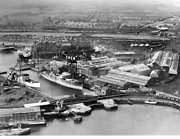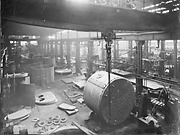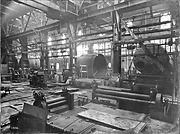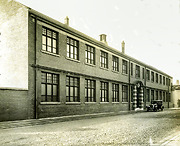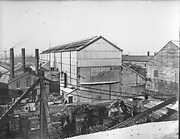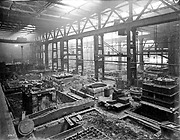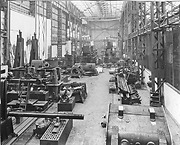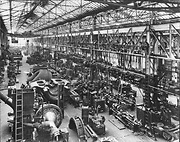 Hartlepool Sports & Leisure
Hartlepool Sports & Leisure
- Cinemas, Theatres & Dance Halls
- Musicians & Bands
- At the Seaside
- Parks & Gardens
- Caravans & Camping
- Sport
 Hartlepool Transport
Hartlepool Transport
- Airfields & Aircraft
- Railways
- Buses & Commercial Vehicles
- Cars & Motorbikes
- The Ferry
- Horse drawn vehicles
 A Potted History Of Hartlepool
A Potted History Of Hartlepool
- Unidentified images
- Sources of information
- Archaeology & Ancient History
- Local Government
- Printed Notices & Papers
- Aerial Photographs
- Events, Visitors & VIPs
 Hartlepool Trade & Industry
Hartlepool Trade & Industry
- Trade Fairs
- Local businesses
- Iron & Steel
- Shops & Shopping
- Fishing industry
- Farming & Rural Landscape
- Pubs, Clubs & Hotels
 Hartlepool Health & Education
Hartlepool Health & Education
- Schools & Colleges
- Hospitals & Workhouses
- Public Health & Utilities
- Ambulance Service
- Police Services
- Fire Services
 Hartlepool People
Hartlepool People
 Hartlepool Places
Hartlepool Places
 Hartlepool at War
Hartlepool at War
 Hartlepool Ships & Shipping
Hartlepool Ships & Shipping

C.M.E.W. Works and People
Details about C.m.e.w. Works And People
Images and stories from the people who worked at The Central Marine Engine Works.
Location
Related items () :
 Alpherat (2)
Alpherat (2)
 Created by unknown
Donated by Bert Spaldin
Created by unknown
Donated by Bert SpaldinPart of the Bert Spaldin collection
The steamship Alpherat fitting out at CMEW.
More detail » Alpherat at CMEW
Alpherat at CMEW
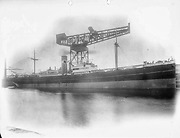 Part of the Hartlepool Library Services collection
Part of the Hartlepool Library Services collectionMV Alpherat at CMEW Dock
More detail » Back of the Boiler Shops
Back of the Boiler Shops
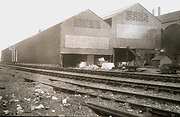 Donated by Mr. Godfrey Saunders
Donated by Mr. Godfrey SaundersThe back of the CMEW Boiler Shops, date unknown.
More detail » Boiler Shop under construction
Boiler Shop under construction
 Donated by Mr. Godfrey Saunders
Donated by Mr. Godfrey SaundersThe CMEW Boiler Shop under construction.
More detail » Boiler being lifted by CMEW Crane
Boiler being lifted by CMEW Crane
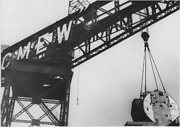 Donated by Hartlepool Museum Service
Donated by Hartlepool Museum ServiceBoiler being lifted by CMEW Crane.
More detail » CMEW Apprentices: Erik Banck 1
CMEW Apprentices: Erik Banck 1
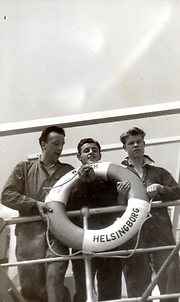 Created by Unknown
Donated by Stuart James Wilson
Created by Unknown
Donated by Stuart James WilsonDated 1948
Pictured are Floss Folland (standing), Johhny Lee and Armstrong.
More detail » CMEW Apprentices: Erik Banck 2
CMEW Apprentices: Erik Banck 2
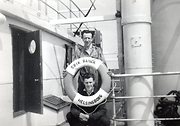 Created by Unknown
Donated by Stuart James Wilson
Created by Unknown
Donated by Stuart James WilsonDated 1948
Floss Folland (standing) and Johnny Lee aboard the s.s. Erik Banck. Johnny Lee was a good friend of Jim Wilson. After going to sea as a Merchant Navy engineer, Johnny worked for a US petrochemical company in Bahrain. Jim was best man at his wedding. Married to Mary, John ran facilities operations at the London Hilton Hotel.
More detail » CMEW Apprenticeship Certificate and Reference
CMEW Apprenticeship Certificate and Reference
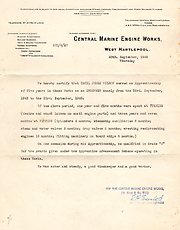 Created by Unknown
Donated by Stuart James Wilson
Created by Unknown
Donated by Stuart James WilsonDated 1948
Belonging to Jim Wilson.
More detail » CMEW Crane
CMEW Crane
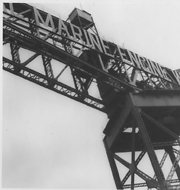 Created by Bill Boagey
Donated by Hartlepool Museum Service
Created by Bill Boagey
Donated by Hartlepool Museum ServicePart of the Bill Boagey collection
CMEW Crane.
More detail » CMEW Crane
CMEW Crane
 Donated by Hartlepool Museum Service
Donated by Hartlepool Museum ServiceCMEW Crane with the works in the background.
More detail » CMEW Crane at night
CMEW Crane at night
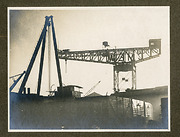 Donated by Hartlepool Museum Service
Donated by Hartlepool Museum ServiceThis picture was taken at night with the light from the fire in the background.
More detail » CMEW Crane under construction
CMEW Crane under construction
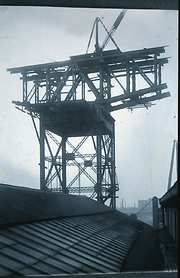 Donated by Mr. Godfrey Saunders
Donated by Mr. Godfrey SaundersThe iconic CMEW Hammerhead Crane under construction.
More detail » CMEW National Shell Factory
CMEW National Shell Factory
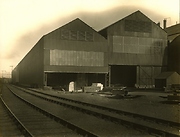 Part of the Hartlepool Museum Service collection
Part of the Hartlepool Museum Service collectionDated 1915
A view of the CMEW buildings converted for the production of artillery shells, looking East, December 1915.
More detail » CMEW panorama
CMEW panorama
 Created by unknown
Donated by Les Hawksfield
Created by unknown
Donated by Les HawksfieldA 'stitched' image from a number of photographs taken from the top of the sheer legs opposite the CMEW works.
More detail » CMEW works offices 2
CMEW works offices 2
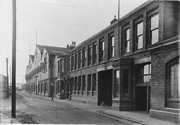 Donated by Douglas Ferriday
Donated by Douglas FerridayPart of the Hartlepool Library Service collection
CMEW works and offices.
More detail » Cairngowan fitting out
Cairngowan fitting out
 Part of the Hartlepool Library Services collection
Part of the Hartlepool Library Services collectionMV Cairngowan fitting out at CMEW.
More detail » Cargo hatches under construction
Cargo hatches under construction
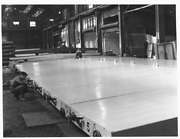 Donated by Douglas Ferriday
Donated by Douglas FerridayPart of the Hartlepool Library Service collection
Cargo hatches under construction at Wm Gray, CMEW, Hartlepool
More detail » Central Dock
Central Dock
 Donated by Hartlepool Museum Service
Donated by Hartlepool Museum ServicePart of the Shipbuilding collection
A view from Central Dock looking towards Central Marine Engineering Works.
More detail » Central Marine Engine Works, Accident Report Form
Central Marine Engine Works, Accident Report Form
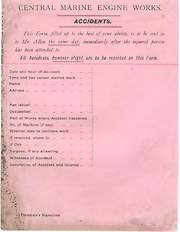 Donated by Hartlepool Library Service
Donated by Hartlepool Library ServiceAn accident report form for the works.
More detail » Central Marine Engineering Works c1885
Central Marine Engineering Works c1885
 Donated by Hartlepool Museum Service
Donated by Hartlepool Museum ServiceCentral Marine Engineering Works c1885
More detail » Charles Stevens Testimonial
Charles Stevens Testimonial
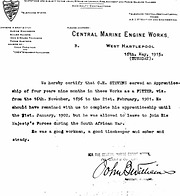 Donated by Mr. Peter Stevens
Donated by Mr. Peter StevensDated 1915
A testimonial letter from CMEW written for Charles Henry Stevens in 1915, believed to help him enlist with the RNVR as an engine room artificer to fight in the Great War. It seems to have been successful as Charles served on the protected cruiser, HMS Edgar, seeing action in the Mediterranean and The Dardanelles.
More detail » Dockside View
Dockside View
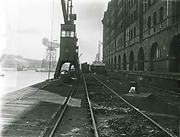 Donated by Hartlepool Library Service
Donated by Hartlepool Library ServiceLarge warehouse on right of image, CMEW (Central Marine Engine Works) in the background. Timber in wagons.
HHT&N795
More detail » End of an era
End of an era
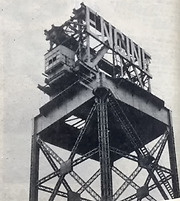 Created by NDM
Donated by Hartlepool Museum Service
Created by NDM
Donated by Hartlepool Museum ServiceDated 1964
Taken in october 1964, the CMEW crane being dismantled And the caption read ' Death of a Giant'.
More detail » Fleet Repair Bases Overseas Letter
Fleet Repair Bases Overseas Letter
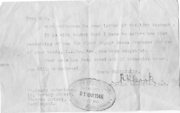 Donated by Mrs. Jean Sutherland
Donated by Mrs. Jean SutherlandDated 1945
A letter from the Combined Recruiting Centre, Middlesbrough, informing Henry Robertson that the Royal Navy no longer required Moulders for their Fleet Repair Bases Overseas.
More detail » Four women in a lifeboat
Four women in a lifeboat
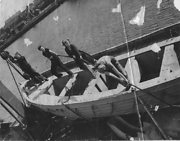 Donated by Hartlepool Museum Service
Donated by Hartlepool Museum ServiceFour women in a lifeboat aboard a ship. Ship believed to be The Empire Nigel.
More detail » Frame Bending
Frame Bending
 Part of the Hartlepool Library Services collection
Part of the Hartlepool Library Services collectionFrame bending at Central Yard
More detail » Frame Bending (2)
Frame Bending (2)
 Donated by Hartlepool Museum Service
Donated by Hartlepool Museum ServicePart of the Shipbuilding collection
Frame bending at CMEW. Workers posing for photograph.
More detail » Harold Lumsden Watson - Indenture
Harold Lumsden Watson - Indenture
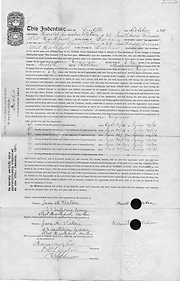 Donated by Mrs. Pauline Watson
Donated by Mrs. Pauline WatsonDated 1914
On October 12th, 1914, Harold Watson began a 6-year apprenticeship with William Gray & Co. Ltd., learning the skills to become an Engineer.
More detail » Hartlepools National Shell Factory
Hartlepools National Shell Factory
At the outbreak of war, in August 1914, there was in course of construction a large Boiler Shop at the Central Marine Engine Works, West Hartlepool, which was to be used for the purpose of making large marine boilers.
Owing to the urgent demand for shells which then existed, this shop was offered to the Government on the 29th May, 1915. Nothing definite was arranged at that time, but on 18th November, 1915, after the establishment of the Tyne and Wear Board of Management, definite arrangements were made for the purpose of utilising this shop, which was then named the Hartlepools National Shell Factory, as a Shell factory.
The Central Marine Engine Works equipped, organised and managed the Factory.
The building consisted of two bays 500 feet and 600 feet long respectively, each bay being 47½ feet in width, and equipped with overhead electric travelling cranes. The Factory was fitted with machinery supplied by the Ministry of Munitions, and all the necessary tools for making 1,400 8” H.E. shells per week, from forgings.
A commencement was made in the production of shells in July 1916, and from that time the output steadily rose, until a maximum of 1,700 shells per week was produced. The total number of shells made in the period during which the Factory was at work, namely 16 months, was 81,346. The number of employees was 85 males and 365 women. All the machines were operated by women, and also all the handling of the shells by means of specially designed overhead travelling cranes.
The Factory was visited by the King and Queen on the 14th June, 1917, who expressed their appreciation of the work which was being done.
At the end of 1917, when the demand for marine machinery became so acute, the Admiralty arranged with the Ministry that the Shell Factory should revert to its original use as a Boiler Shop.
A commencement was then made in dismantling the Factory, and the production of shells gradually came to an end.
The outstanding feature in the production of shells from the Factory, was the large percentage of women labour employed in the production of such large shells as 8”, over 82% of the labour being women; also, the cost of shells produced was remarkably low, and ranked second of the National Factories.
The personnel of the Factory Management was as follows:
Chairman (Wm. Gray & Co. Ltd.) – Sir William Gray, Bart.
Managing Director (Central Marine Engine Works) – Maurice Gibb
Works Manager – M. Warren
Assistant Manager – John B. Williams
Commercial Manager – W.H. Allen
Factory Foreman – J. Baglee
Lady Superintendant – Miss W. Sivewright
The Tyne & Wear Board of Management: Engineer and Secretary – Captain J.W. Bruce
The photographs show the buildings, machines and the work of the women who operated them to produce much-needed ammunition for the Front. The women were involved in every part of the production process, from operating overhead magnetic cranes and hydraulic presses, to the very high-precision work of boring, turning and milling shell cases.
Sadly we don't know the names of any of the workers in these photographs, so, for those images in which faces are clearly distinguishable, we have created 'mini-galleries' of close-up shots, in the hope that someone might recognise a family member. If you do recognise someone, or have any other information about this factory, then please contact us.
Further details about shell manufacture in the North-East have been posted as 'blogs' by Tyne & Wear Museum Services: http://www.twmuseums.org.uk/engage/blog/the-neptune-shell-shop-bracelet-and-the-response-to-the-shell-crisis-of-1915-part-1/ and http://www.twmuseums.org.uk/engage/blog/the-neptune-shell-shop-bracelet-and-the-response-to-the-shell-crisis-of-1915-part-2/
 Henry Robertson Apprenticeship
Henry Robertson Apprenticeship
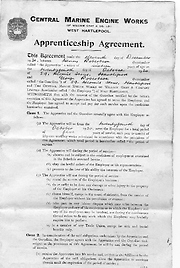 Donated by Mrs. Jean Sutherland
Donated by Mrs. Jean SutherlandDated 1930
The first page of Henry Robertson's 5-year Apprentice agreement, to learn the skills of an Iron Founder, at the Central Marine Engine Works. Henry's apprenticeship ran from 1930-35.
More detail » Henry Robertson CMEW reference
Henry Robertson CMEW reference
 Donated by Mrs. Jean Sutherland
Donated by Mrs. Jean SutherlandDated 1945
A reference letter from CMEW for Henry Robertson, confirming that he successfully completed his apprenticeship with the company and was a good worker.
More detail » Ian Kennedy Apprecticeship Agreement (1)
Ian Kennedy Apprecticeship Agreement (1)
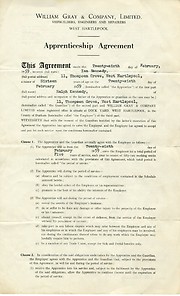 Donated by Ian Kennedy
Donated by Ian KennedyOne of four pages of Ian Kennedy's apprecticeship agreement with William Gray & Company Limited dated February 1959
More detail » Ian Kennedy Apprecticeship Agreement (2)
Ian Kennedy Apprecticeship Agreement (2)
 Donated by Ian Kennedy
Donated by Ian KennedyOne of four pages of Ian Kennedy's apprecticeship agreement with William Gray & Company Limited dated February 1959
More detail » Ian Kennedy Apprecticeship Agreement (3)
Ian Kennedy Apprecticeship Agreement (3)
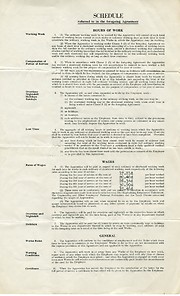 Donated by Ian Kennedy
Donated by Ian KennedyOne of four pages of Ian Kennedy's apprecticeship agreement with William Gray & Company Limited dated February 1959
More detail » Ian Kennedy Apprecticeship Agreement (4)
Ian Kennedy Apprecticeship Agreement (4)
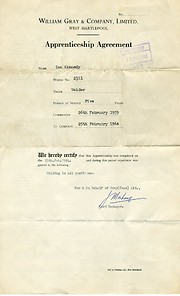 Donated by Ian Kennedy
Donated by Ian KennedyOne of four pages of Ian Kennedy's apprecticeship agreement with William Gray & Company Limited dated February 1959
More detail » Irvine's Quay - Middleton Shipyard (1)
Irvine's Quay - Middleton Shipyard (1)
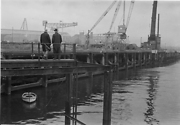 Donated by Hartlepool Museum Service
Donated by Hartlepool Museum ServiceIrvine's Quay, Middleton Shipyard showing method of construction. Swan Neck Crane and CMEW Hammer Head Crane in the background.
More detail » James Henry Hogg Apprenticeship Agreement (1)
James Henry Hogg Apprenticeship Agreement (1)
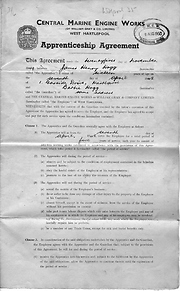 Donated by Keith Alder
Donated by Keith AlderDated 1948
One of four pages of James Henry Hogg's Apprenticeship Agreement with CMEW in 1948.
More detail » James Henry Hogg Apprenticeship Agreement (2)
James Henry Hogg Apprenticeship Agreement (2)
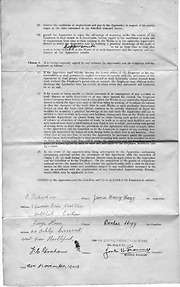 Donated by Keith Alder
Donated by Keith AlderDated 1948
Second of four pages of James Henry Hogg's Apprenticeship Agreement with CMEW in 1948.
More detail » James Henry Hogg Apprenticeship Agreement (3)
James Henry Hogg Apprenticeship Agreement (3)
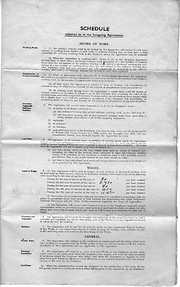 Donated by Keith Alder
Donated by Keith AlderDated 1948
Third of four pages of James Henry Hogg's Apprenticeship Agreement with CMEW in 1948.
More detail » James Henry Hogg Apprenticeship Agreement (4)
James Henry Hogg Apprenticeship Agreement (4)
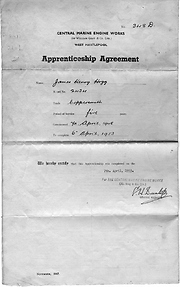 Donated by Keith Alder
Donated by Keith AlderDated 1948
Fourth of four pages of James Henry Hogg's Apprenticeship Agreement with CMEW in 1948.
More detail » Jim Wilson Apprenticeship Agreement: Page 1
Jim Wilson Apprenticeship Agreement: Page 1
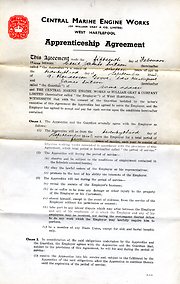 Created by Unknown
Donated by Stuart James Wilson
Created by Unknown
Donated by Stuart James WilsonDated 1944
Jim served his time as a marine engineer with the Central Marine Engine Works of William Gray's shipyard between 1943 and 1948.
More detail » Jim Wilson Apprenticeship Agreement: Page 2
Jim Wilson Apprenticeship Agreement: Page 2
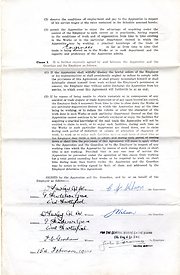 Created by unknown
Donated by Stuart James Wilson
Created by unknown
Donated by Stuart James WilsonDated 1944
Jim served his apprenticeship as a marine engineer at the Central Marine Engine Works of Gray's shipyard between 1943 and 1948.
More detail » Jim Wilson Apprenticeship Agreement: Page 3
Jim Wilson Apprenticeship Agreement: Page 3
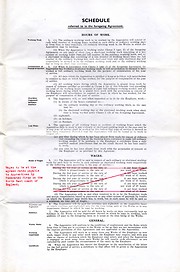 Created by unknown
Donated by Stuart James Wilson
Created by unknown
Donated by Stuart James WilsonDated 1944
Jim served his time as a marine engineer at the Central Marine Engine Works of Gray's shipyard between 1943 and 1948.
More detail » Jim Wilson Apprenticeship Agreement: Page 4
Jim Wilson Apprenticeship Agreement: Page 4
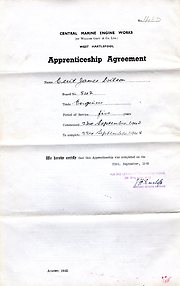 Created by Unknown
Donated by Stuart James Wilson
Created by Unknown
Donated by Stuart James WilsonDated 1944
Jim served his apprenticeship as a marine engineer with the Central Marine Engine Works of Gray's shipyard between 1943 and 1948.
More detail » Jim Wilson Apprenticeship Indentures: Envelope
Jim Wilson Apprenticeship Indentures: Envelope
 Created by Unknown
Donated by Stuart James Wilson
Created by Unknown
Donated by Stuart James WilsonDated 1948
Jim served his apprenticeship as a marine engineer with the Central Marine Engine Works of Gray's shipyard.
More detail » Jim Wilson: CMEW Engineering Apprentice
Jim Wilson: CMEW Engineering Apprentice
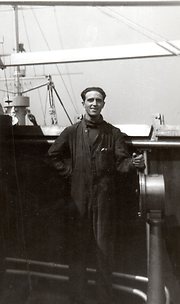 Created by Unknown
Donated by Stuart James Wilson
Created by Unknown
Donated by Stuart James WilsonDated 1948
Photograph, looking forrard, taken by the starboard bridge-wing telegraph of the s.s. Erik Banck.
More detail » Joseph Chapman Dalkin - Testimonial
Joseph Chapman Dalkin - Testimonial
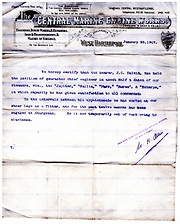 Donated by Mrs. Eileen Manners
Donated by Mrs. Eileen MannersDated 1907
A testimonial letter from CMEW relating to Joseph Dalkin's time as an Engineer with the company.
More detail » King George V and Queen Mary at CMEW
King George V and Queen Mary at CMEW
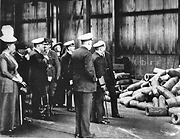 Created by unknown
Donated by Hartlepool Museum Service
Created by unknown
Donated by Hartlepool Museum ServiceDated 1917
King George V (centre) and Queen Mary (left) on a tour of the factory, on June 14th, 1917.
HHT&N 586
More detail » Launch of an unknown ship
Launch of an unknown ship
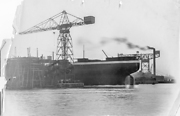 Donated by Hartlepool Museum Service
Donated by Hartlepool Museum ServicePart of the Shipbuilding collection
Launch of an unknown ship at Gray's CMEW yard.
More detail » Letter of thanks from King George V
Letter of thanks from King George V
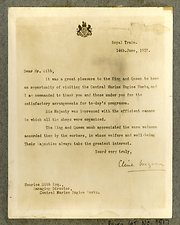 Part of the Hartlepool Museum Service collection
Part of the Hartlepool Museum Service collectionDated 1914
Written to Maurice Gibb, managing director of CMEW , by Clive Wigram on behalf of King George V from the Royal Train on June 14th 1917 following a visit that day by King George and Queen Mary.
More detail » Lifting Bridge section of Windward Passage
Lifting Bridge section of Windward Passage
 Donated by Hartlepool Library Service
Donated by Hartlepool Library ServiceLifting Bridge section of Windward Passage by CMEW crane in the North Basin.
More detail » MV Mabel Warwick
MV Mabel Warwick
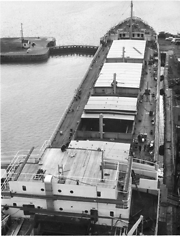 Donated by Hartlepool Museum Service
Donated by Hartlepool Museum ServiceMV Mabel Warwick at berth. Picture taken from the CMEW Crane.
More detail » MV Titanian
MV Titanian
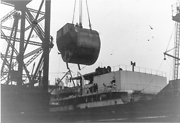 Donated by Hartlepool Museum Service
Donated by Hartlepool Museum ServiceMV Titanian. New boiler being lifted on board in the CMEW yard during the 1930s.
More detail » MV Titanian
MV Titanian
 Donated by Hartlepool Museum Service
Donated by Hartlepool Museum ServiceMV Titanian. New boiler being lifted on board in the CMEW yard during the 1930s.
More detail » MV Titanian
MV Titanian
 Donated by Hartlepool Museum Service
Donated by Hartlepool Museum ServiceMV Titanian. New boiler being lifted on board in the CMEW yard during the 1930s.
More detail » MV Titanian
MV Titanian
 Donated by Hartlepool Museum Service
Donated by Hartlepool Museum ServiceMV Titanian. New boiler being lifted on board in the CMEW yard during the 1930s.
More detail » MV Titanian
MV Titanian
 Donated by Hartlepool Museum Service
Donated by Hartlepool Museum ServiceMV Titanian. New boiler being lifted on board in the CMEW yard during the 1930s.
More detail » MV Titanian
MV Titanian
 Donated by Hartlepool Museum Service
Donated by Hartlepool Museum ServiceMV Titanian. New boiler being lifted on board in the CMEW yard during the 1930s.
More detail » MV Titanian
MV Titanian
 Donated by Hartlepool Museum Service
Donated by Hartlepool Museum ServiceMV Titanian. New boiler being lifted on board in the CMEW yard during the 1930s.
More detail » MV Titanian
MV Titanian
 Donated by Hartlepool Museum Service
Donated by Hartlepool Museum ServiceMV Titanian. New boiler being lifted on board in the CMEW yard during the 1930s.
More detail » MV Titanian
MV Titanian
 Donated by Hartlepool Museum Service
Donated by Hartlepool Museum ServiceMV Titanian. New boiler being lifted on board in the CMEW yard during the 1930s.
More detail » MV Titanian
MV Titanian
 Donated by Hartlepool Museum Service
Donated by Hartlepool Museum ServiceNew boiler for the Titanian in the 1930s. At CMEW yard.
More detail » MV Titanian
MV Titanian
 Donated by Hartlepool Museum Service
Donated by Hartlepool Museum ServiceMV Titanian. New boiler being lifted on board in the CMEW yard during the 1930s.
More detail » MV Titanian
MV Titanian
 Donated by Hartlepool Museum Service
Donated by Hartlepool Museum ServiceMV Titanian. New boiler being lifted on board in the CMEW yard during the 1930s.
More detail » MV Titanian
MV Titanian
 Donated by Hartlepool Museum Service
Donated by Hartlepool Museum ServiceMV Titanian. New boiler being lifted on board in the CMEW yard during the 1930s.
More detail » Magnet crane (1)
Magnet crane (1)
 Created by unknown
Donated by Hartlepool Museum Service
Created by unknown
Donated by Hartlepool Museum ServiceMagnet crane workers.
More detail » Magnet crane (2)
Magnet crane (2)
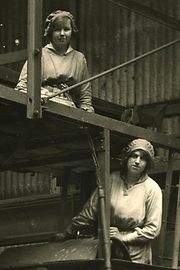 Created by unknown
Donated by Hartlepool Museum Service
Created by unknown
Donated by Hartlepool Museum ServiceMagnet crane workers.
More detail » Main Machine Shop
Main Machine Shop
 Donated by Mr. Godfrey Saunders
Donated by Mr. Godfrey SaundersThe CMEW Main Machine Shop. The second machine on the right was that used by Godfrey Saunders.
More detail » Mary Holt at CMEW
Mary Holt at CMEW
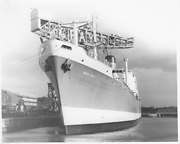 Part of the Hartlepool Library Services collection
Part of the Hartlepool Library Services collectionMV Mary Holt at CMEW
More detail » Memories of the William Gray Shipyard and CMEW
Memories of the William Gray Shipyard and CMEW
MEMORIES OF THE Wm. GRAY SHIPYARDS & CENTRAL MARINE ENGINE WORKS.
by Derek Hinds.
My earliest memories of shipping was when I was around five years old, when my father, who worked in the Wm. Gray shipyards as a charge-hand lathe turner, at their Graythorp ship-repair centre, took me to see a ship launched. The date was 8th July 1948 and the ship was the IRISH CEDAR, (No.1219), a 5,627grt. general cargo ship being built by the Gray yards for the Irish Shipping Company, from Dublin, Ireland. She was completed in February 1949. Re-named:- MUSTANSIR in 1959, and was broken up at Karachi from 15th January 1971.
There was a spell of seven years before I watched the next ship launched. That was on 21st July 1955, at the Central Yard, when the bulk iron ore carrier OREGIS, (No.1272), 6,858grt, was being built for Houlder Brothers Ore Carriers Ltd. She was completed in November 1955. In 1972 she was converted into an RV-DSS. There was some excitement on the River Tyne as she was sailing following her conversion, she ran aground adjacent to the Black Middens rocks near to the river mouth. She was refloated and repaired. Re-named:- 1974 - HTS COUPLER 1; 1975 – OREGIS. She was broken up at Vigo from February 1983.
It was whilst I was at secondary school that I became more interested in ships and shipping. During our lunch break myself and a classmate used to cycle down to the docks to see what shipping was in port. At the secondary school we could see the shipyards from the upstairs classroom windows. The approaching time for a launch was when the ship’s hull was painted in its future owning companies colours, and a lot of the clutter of staging etc. was taken down. Over the next two years I witnessed nearly every launch from the Wm Gray yards.
They were: -s.s ANATOLIAN (No.1281) – Launched:- 21st June 1955, from the Dock Yard. Completed:- November 1955, for Ellerman Papayanni Ltd., 3,799grt. Re-named:- 1963 – CITY OF DURHAM; 1964 – ANATOLIAN; 1966 – ASCANIA; 1966 – ANATOLIAN; 1968 – ASCANIA; 1968 – ANATOLIAN; 1968 – AGIA SOPHIA; 1971 – FULKA; 1973 – KHALID; 1975 – GULF UNITY. B/U:- at Gadani Beach, 19th Feb.1978.
s.s LANCASTRIAN (No.1282) – Launched:- 14th October 1955,from the Dock Yard. Completed:- February 1956 for Ellerman Papayanni Ltd., 3,799grt. Re-named:- 1962 – CITY OF LEICESTER; 1964 – LANCASTRIAN; 1966 – ALSATIA; 1966 – LANCASTRIAN; 1969 – THEOKRATES; 1974 – KHORFAKAN. Wrecked:- 12th February 1975 on Sharjah Jetty.
m.v PEARL STONE (No.1274) – Launched:- 31st October 1955, from the Central Yard. Completed:- March 1956 for N.G. Livanos Co., Greece. 8,001grt. Re-named:- 1969 – TARPON SURF; 1974 – CHRISTOS. B/U:- at Gadani Beach, 18th August 1977.
m.v LOTTINGE (No.1280) – Launched:- 30th January 1956, from the Dock Yard.
Completed:- July 1956, for Constants Ltd. 4,215grt. Re-named:- 1974 – SAMANTHA M; 1975 – CUNSKI; 1991 – SHAHINAZ. B/U:- Alang, 23rd January 1992.
m.v ORMINA (No.1273) – Launched:- 28th February 1956, from the Central Yard.
Completed:- May 1956 for Houlder Bros. Ore Carriers Ltd. 6,858grt. Re-named:- 1974 – GENERALE FEDERICO. B/U:- at Vado Ligure, 16th April 1986.
m.v IRISH LARCH (No.1275) – Launched:- 11th June 1956, from the Central Yard. Completed:- October 1956 for Irish Sjipping Ltd. 8,283grt. Re-named:- ALIAKMON PROGRESS. B/U:- Inchon, 28th November 1979.
m.v IRISH MAPLE (No.1276) – Launched:- 3rd October 1956, from the Central Yard. Completed:- February 1957 for Irish Shipping Ltd. 8,288grt. Re-named:- 1968 – ALIAKNON PIONEER; 1979 – ANNOOR. B/U:- Gadani Beach, 2nd March 1982.
s.s CASTLEDORE (No.1284) – Launched:- 20th October 1956, from the Dock Yard. Completed:- December 1956, for Michalinos & Co. Ltd. 7,952grt. B/U:- Suao, 20th July 1974.
m.v PEARL SEA (No.1283) – Launched:- 19th December 1956, from the Central Yard. Completed:- April 1957, for N.G. Livanos Co., Greece. 7,977grt. Re-named:- 1969 – TARPON SEA; 1975 – DAPO SEA. Fire at Sitra Anchorage, Bahrain 1st June 1977. B/U:- Gadani Beach, 29th October 1977.
s.s LUCY (No.1285) – Launched:- 1st February 1957, from the Dock Yard. Completed:- May 1957, for N.G. Livanos Co., Greece. 7,583grt. Re-named:- 1973 – LEONIDAS MICHALOS; 1980 – BLESSING FIVE. B/U:- Visakhapatnam, 30th March 1981. Her steam plant was removed by her builders in 1961, and a diesel engine was then installed.
m.v IRISH ALDER (No.1286) – Launched:- 30th May 1957, from the Central Yard.
Completed:- September 1957 for Irish Shipping Ltd. 8,226grt. Re-named:- 1971 – ALIAKMON PILOT; 1977 – ATTICAN UNITY. Fire & beached Flushing Roads, 25th September 1977. B/U:- Bremen, 22nd March 1978.
s.s ROSE OF LANCASTER (No.1290) – Launched:- 29th July 1957, from the Dock Yard. Completed:- December 1957, for Guinea Gulf Lines. 5,197grt. Re-named:- 1965 – BOCNA. Fire at Matadi, Zaire, 24th December 1977. B/U:- Split, 23rd March 1978. This ship was fitted with a steam turbine for its main engine.
m.v IRISH ASH (No.1287) – Launched:- 24th September 1957, from the Central Yard. Completed:- January 1958, for Irish Shipping Ltd. 8,269grt. Re-named:- ALIAKMON POWER. B/U:- Ulsan, 20th June 1979.
m.v PEARL BEACH (No.1288) – Launched:- 12th December 1957, from the Central Yard. Completed:- April 1958 for N.G. Livanos, Co., Greece. 8,692grt. Re-named:- TARPON SWIFT; 1977 – TAPROBANE GOODRICH. B/U:- Kaohsiung, 27th August 1979.
m.v LORADORE (No.1291) – Launched:- 6th February 1958, from the Dock Yard.
Completed:- June 1958, for Constants Ltd. 8,077grt. Re-named:- 1966 – ALIARTOS; 1970 – THOMAS A; 1975 – IRENES BANNER. Fire at Dawes Is. Anchorage, Bonny River, 19th January 1978, & Beached.
m.v PEARL CREEK (No.1289) – Launched:- 19th May 1958, from the Central Yard. Completed:- September 1958, for N.G. Livanos, Co., Greece. 8,692grt. Re-named:- 1974 – LEODAMAS; 1978 – ZINOVIA. Wrecked:- 24th September 1979. B/U:- Gadani Beach, 3rd December 1980.
I left school at 15, and, as I was still interested in shipping, it was natural that I followed my Father into the shipyards. I started work as the ‘General Store Boy’ at the Central Marine Engine Works, of the Wm. Gray & Co. shipyards, of West Hartlepool. Running errands and issuing stores as required. I also learnt some of the tradesmen tricks like:- ‘Go to the store for a long stand,’ (which we duly obliged with, until the person asked why we weren’t serving him, when we said ‘well! you requested a long stand’). or ‘Go for a capful of nail holes,’ (for a joiner or carpenter) or ‘Go for a bucket full of steam to test this ------ .’ etc. etc. I also learnt from other people’s mistakes, like measuring up for bolts and forgetting to allow for the nut and possible washer(s), which was a regular occurrence.
During my time in the General Store I assisted with the engineering stores for the following ships which were being built in the yards:-
m.v CLEVELAND (No.1293) – Launched:- 31st July 1958, from the Central Yard. Completed:- November 1958, for Stephenson, Clark Ltd. 8,619grt. Re-named:- 1964 – VENICE; 1978 – HONG QI 131. Deleted:- 2002.
m.v RIVERDORE (No.1294) – Launched:- 30th September 1958, from the Dock Yard. Completed:- March 1959, for Constants Ltd. 8,080grt. Re-named:- 1974 – SHAH-E-RAZA; 1975 – AL KARIM; 1978 – BACHDANG; 1980 – EASTERN CONQUEST. B/U:- Gadani Beach, 8th March 1982.
m.v DEGEMA (No.1295) – Launched:- 27th November 1958, from the Central Yard. Completed:- April 1959, for Elder Dempster Lines. 8,138grt. Re-named:- 1979 – VEEJUMBO; 1982 – DEGEMA. B/U:- Gadani Beach, 30th January 1983.
m.v DIXCOVE (No.1296) – Launched:- 25th March 1959, from the Central Yard. Completed:- June 1959, for Elder Dempster Lines. 8,138grt. Re-named:- 1979 – GULF EAGLE. B/U:- Chittagong, 15th June 1983.
s.s MARY HOLT (No.1300) – Launched:- 21st May 1959, from the Dock Yard. Completed:- October 1959, for Guinea Gulf Line. 5,577grt. Re-named:- 1965 – SIPSAH. B/U:- Gadani Beach, 1st February 1975.
This ship was fitted with a steam turbine for its main engine. It was also the last steam turbine to be built by Gray’s in the Central Marine Engine Works.
m.v PEARL HAVEN (No.1292) – Launched:- 5th October 1959, from the Dock Yard. Completed:- January 1960, for N.G. Livanos, Co., Greece. 8,693grt. Re-named:- 1968 – THETIS; 1973 – EVANGELISMOS; 1975 – ANGLIA; 1976 – CHIOS. B/U:- Kaohsiung, 4th October 1979. This was the last ship to be launched from the Dock Yard slipways.
After a spell of nearly a year in the General Store, it was time for me to move into the Engine Works to start serving my apprenticeship as an engineer. I started on light machining, turret lathes, drilling, milling and slotting. Marking off castings, and materials before they went for machining. Following a spell of working on boiler fittings I was moved into the Offices doing progress and planning, until the demise of the engine works. With people leaving at this time, taking up new jobs elsewhere, I was moved back out of the offices to marking off, as I was one of the last apprentices with that experience.
Whilst I was serving my apprenticeship the other ships that were built and completed by the Gray’s yard were:-
m.v MABEL WARWICK (No.1301) – Launched:- 14th February 1960, from the Central Yard. Completed:- June 1960, for Houlder Bros., Ore Carriers Ltd. 11,632grt. Re-named:- 1976 – NIKOLAS MALEFAKIS; 1980 – RUBINI. B/U:- Eleusis, 8th June 1983, following engine damage 10th -14th July 1982.
m.v IRISH SYCAMORE (No.1302) – Launched:- 17th January 1961, from the Central Yard. Completed:- May 1961, for Irish Shipping Co. 10,560grt. Re-named:- 1973 – MARIA; 1978 – ELIANE; 1980 – MALDIVE NOBLE. B/U:- Alang, 7th April 1984.
m.v JOYA McCANCE (No.1307) – Launched:- 11th July 1960, from the Central Yard. Completed:- October 1960, for Houlder Bros., Ore Carriers Ltd. 11,871grt. Re-named:- 1966 – ST MARGARET; 1978 – HADIOTIS; 1987 – MARITIMA VI (Barge). Stranded:- River Orinoco, 12th July 1985. B/U:- Turkey, 1989 / 90.
m.v BLANCHLAND (No.1303) – Launched:- 29th June 1961, from the Central Yard. Completed:- November 1961, for Stephenson, Clark Ltd. 8,999grt. Re-named:- 1968 – EUGENIA M; 1982 – IONION PRINCESS. B/U:- Qinhuangdao, January 1986. Damaged by an explosion, August 1985.
The BLANCHLAND was the last ship to be built by the Wm. Gray shipyard and the Central Marine Engine Works at West Hartlepool. The company ceased trading a year or so after the last ship sailed away.
It was during my lunch breaks that I first became aware of the Ben Line and their ships. (This was the company which I later joined, and sailed, for a few years, on some of their steamships.) Sitting on the quayside one day, I watched first, the BENARTY, a heavy lift vessel, of 7,795grt, sail from Hartlepool, to be replaced in port the next day by the BENLEDI,an identical sister ship. She remained in the port for a few years until she in turn was replaced by another similar sister ship the BENALBANACH.
The BENARTY was built in 1945 as the EMPIRE WALLACE, joining Ben Line in 1956. Sold in 1962 she was renamed ELYS HARBOUR, over the next few years she was renamed UNIQUE DEVELOPER; FERMENCO; AVALON and BAHIA COLOMBIA. She was broken up at Chittagong in 1988.
BENLEDI was also built in 1945 as the EMPIRE ADMIRAL, renamed PETER DAL, before she joined Ben Line in 1951. She was sold in 1963 and was renamed ANDROS TOMENNO later to become UNIQUE CARRIER before she was broken up at Kaohsiung, Taiwan, in 1969.
BENALBANACH was built in 1946 as the EMPIRE ATHELSTAN, Ben Line acquired her in1947. She was sold in 1966 to the Ministry of Transport and was renamed CAMELOT. In 1969 she was again sold and was renamed DRAGON CASTLE. Following another sale she finally arrived for breaking up at Split, Yugoslavia in 1975.
I was later to learn, when I joined the Ben Line, that the vessels in Hartlepool were on a Government Charter, which meant one of the vessels had to be in a U.K. port at all times in case the need arose to transport heavy military equipment by sea. The ships, whilst in port, were manned by a skeleton crew who kept them in a working condition, in readiness in case they were needed.
Just before the final closure of the Gray’s Shipbuilding Yards, I was transferred to the J. Readheads shipyard and engine works at South Shields, on Tyneside, were I spent eighteen months, until I had completed my apprenticeship.
More detail » Mould Loft CMEW
Mould Loft CMEW
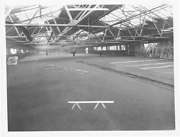 Part of the Hartlepool Library Services collection
Part of the Hartlepool Library Services collectionThe Mould Loft at CMEW works
More detail » Mr Billy Heron
Mr Billy Heron
 Created by Unknown
Donated by Stuart James Wilson
Created by Unknown
Donated by Stuart James WilsonDated 1950
A good friend of Jim Wilson's and a fellow apprentice at the Central Marine Engine Works. Billy joined the Merchant Navy as an engineer-officer and later ran his own engineering business.
More detail » North Basin on Docks
North Basin on Docks
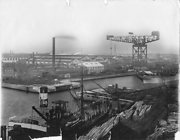 Donated by Hartlepool Museum Service
Donated by Hartlepool Museum ServiceNorth Basin on Docks with the CMEW hammerhead crane at the fitting out berth. Ship to right hand of picture is the MV Portscatho. Another ship discharging timber in the foreground.
More detail » On the CMEW quay
On the CMEW quay
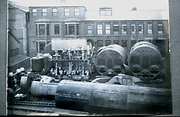 Donated by Mr. Godfrey Saunders
Donated by Mr. Godfrey SaundersBoilers and engines on the CMEW quay, date unknown.
More detail » Platers Shed
Platers Shed
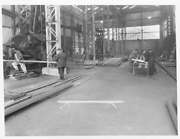 Part of the Hartlepool Library Services collection
Part of the Hartlepool Library Services collectionThe Platers' Shed at CMEW.
More detail » Recollections of the CMEW
Recollections of the CMEW
Recollections of the CMEW by Godfrey Saunders. Reproduced by kind permission of the Tees Packet.
Date of birth:- 26/3/1925. Professional Qualifications:- H.N.C.; C.Eng.; M.I.Mech. E.
Drawing Office Office Boy:- Dec.’39 to mid ’41. Apprentice fitter / turner:- ‘41 to ’46.
This apprenticeship was served as follows:-
18 months machining on drilling machines, centre lathes, chuck lathes etc., in the Auxiliaries Shop. After this I spent some months fitting in the Auxiliaries Shop. As the name implies this was where the auxiliary items where made, such as pumps, small heat exchangers and evaporators.
The next period was spent in the Main Engine Erection Shop on a variety of jobs, assembling the cylinders, the main engine water pumps, and erecting the main engines.
My final stint of practical work was carried out in the Boiler Shop where the boiler tubes were fitted and expanded in place, the boiler stays were fitted and tightened and the stop and safety valves were installed.
Having come second in the annual competitive examination for places in the drawing office, I spent the final 18 months of my apprenticeship there. The work consisted mainly of machinery arrangement and piping drawings.
Journeyman Draughtsman, March 1946 – 48.
Again the work consisted of pipe-work and machinery arrangement drawings, with occasional technical support on sea trials, which were resumed at the cessation of hostilities.
1948 Assistant Technical Officer I.C.I.
This was an euphemism for draughtsmen. The work consisted of plant layout and pipe-work but to a much higher technical standard, as one would expect in the petro-chemical industry.
1955 – 87 STEETLY, Hartlepool Works:-
1955-57 Mechanical Assistant; 1957-63 Assistant Mechanical Engineer;
1963-78 Mechanical Engineer; 1978-87 Engineering Development Manager.
This work entailed design, procurement, installation and commissioning of all new plant and machinery. It included an eight month period in Sardinia to supervise and commission the new plant in San Antioco, and a visit to Japan to advise on a new furnace there. Improved steel-making techniques, calling for higher quality refectories, and less quantity meant that worldwide capability was three times the market demand. Coupled with high interest rates, which meant reduced pay-back times, capital projects became harder to justify. Towards the end of my career I was spending most of my time producing schemes for increasing thermal efficiency or other cost cutting methods, which did not gain the approval of the board because of the capital involved. When offered early retirement I was glad to accept.
HOW I BECAME AN ENGINEER
Two weeks before I was due to sit the scholarship I was taken ill with severe stomach pains. This was diagnosed as an abscess on the pelvis, which was operated on. In consequence I missed that year at school and sat the scholarship a year later. I passed the first half and was duly paraded before Ralph Todd with several others to read to him. It was a bit of a farce as I was subsequently told that I was too old. My mother was determined that I should have a Grammar School education, so I went to Normanhurst, which was then a private school. I am sure that the small staff did their best to teach us, in spite of the limited facilities available, but when, on the outbreak of hostilities, all the staff but one went to serve their country, it was the last straw and the school closed. Previous to this, I had expressed a desire to become a motor mechanic and my parents consulted an old friend who was a garage proprietor. His very sound advice was that I should serve an engineering apprenticeship. This would give me the opportunity to go in for auto-engineering after my apprenticeship, but would leave me with more options.
My mother went to see Monty Warren at the Central Marine Engine Works, (C.M.E.W.), who told her that a job as an office boy had just become vacant in the Drawing Office (D.O.). If I took the job and behaved myself, I could be sure of getting an apprenticeship, otherwise I would have to take my chance. I started just before Christmas 1939.
The Drawing Office was situated on the first floor of the office block, as were all the main offices. It was furthest away from the main entrance and adjoining the Brass Foundry on one side and the Brass Finishing Gallery on another side. The Lathes and other machinery were all powered by a belt drive from line shafting bracketed to the wall, so the design work was carried out to the sound of the Brass foundry crane trundling along its rails and the line shafting rumbling in its bearings. The Drawing Office was alleged to have been designed by the works engineer, Mr. Mallet, and resembled a ship’s engine room, but without the fiddley grating. The main D.O. was divided longitudinally into three by the rows of building columns. Mr. Mallet was notorious for cheese-paring and had ordered the building columns too short, so some strange wooden ornamental pieces adorned the top of the columns to fill in the gaps. The centre third of the building went up to the “engine room skylight”, the two outer thirds had a kind of ‘tween deck arrangement containing the auxiliary D.O. on one side and the tracer’s office on the other. This latter was then unoccupied as the tracers had been accommodated in the main office because of the war.
My duties started with the removal of the blackouts from the windows, going down to the print room and lifting the trapdoor which led to the tracing store below. I had to retrieve the ‘Bible’ which contained the specifications of the ships which we had engined and also the book containing extracts from Lloyds’ register pertaining to Gray built ships. I had to keep this latter book up to date. Every evening my last duty was to return these volumes to the safe, as it was known. My other duties included distribution of drawings to the various workshops and being a general dogsbody for the draughtsmen. This was a valuable introduction to life on the other side of the heavy sliding door separating the offices from the works. My most awesome duty was to take Monty Warren his cup of tea. In the saucer there was a biscuit which he always donated to me, but even this kindness did not lessen the gravity of the occasion. Monty was quietly spoken and I had to listen carefully for his answer to my timid knock. Inside the sanctum, he would be sitting behind his desk looking like a reincarnation of Buddha, although that wasn’t quite what his workforce called him. I was always reminded of the joke in the comics: How do you cure a red nose? Drink until it turns blue. Although he was quietly spoken, the sibilants always whistled through his false teeth. This served as a useful advance warning of his approach. One of his duties as Works Manager was to make a daily tour of the works, accompanied by the Shop Superintendent. His stately progress, reminiscent of a fully rigged ship, was heralded by the aforementioned whistles, audible even above the shop noises, so everybody was usually hard at work when he arrived. Woe be tide you otherwise. One peculiarity that I remember was the way that he walked with his hands turned so that the palms were parallel to the floor.
The Chief Draughtsman at that time was Mr. Ewart Smith, a tall, thin, gangling man, who seemed to live in constant fear that his flies were open, as he used to be constantly checking the front of his trousers while he loped along the corridor towards the Commercial office. His chief claim to fame was that he had written a book on “The measurement of Boiler Shop noise in Decibels”. It was alleged that it only sold one copy. He always ended his remarks by saying “What?” several times. Charlie Morley was the Auxiliary Drawing Office Chief. As the name implies, they produced the designs for all the auxiliary machinery. He was given the top apprentice of each year as all his drawings were produced by apprentices. He was a lovely man, knowledgeable but with a very quick temper. Rumour had it that he had killed a Lascar stoker with a shovel when at sea. He certainly had command of a very lurid vocabulary and when he was in full flow there were times when a choice selection from it would come rolling over the glass patricians of his office into the D.O. below. This caused great consternation among Miss Palliser and her tracers, and an emissary had to be sent to plead for some amelioration of the language.
The Main D.O. staff were split up into sections. The Machinery layout, pipe-work and valves came under Tommy Rutherford, who had bent feet from which all his staff used to suffer, particularly the apprentices. The Engine design work was in charge of Mr. Houlton whose son was ‘Nobby’, later to become head of Brinkburn. He had just retired when war was declared and had been called back into service, much to the annoyance of his men. He too was short tempered and used to bleat like a goat when annoyed. Ozzy Bell looked after the propeller designs and also orders for spares. He taught drawing at evening classes for many years. The boiler design was in the hands of Tommy Tritschler, who was our next door neighbour in Belmont Gardens. He always kept his cards close to his chest as though afraid of others learning his design secrets. As all the boilers were produced were of the Scotch design which had been produced for many years, this seemed a little paranoid.
Other characters at that time included Eugene Panagopoulus. He was a member of a Greek ship owning family, and was there getting experience. I gathered that this was not confined to shipbuilding experience. George Coulthard was Mr. Houlton’s right hand men and was very knowledgeable about engineering matters. He was very helpful and encouraging to me as a humble office boy. Jimmy Davidson was next in seniority to Tommy Rutherford in the machinery arrangement section. The son of a Scots Engineer, he and his father were veterans from the early days of motoring, having built their own engine and attached it to their tandem. They learnt the hard way that front forks needed strengthening to meet the increased stresses. He was the proud possessor of a 1930 two cylinder Jowett with fabric body, remarkable for its pulling power and economy. Harold Peacock was a member of Tommy Rutherford’s section. He had a very laid back approach to things, which meant that he and Tommy Rutherford would often be in conflict. The apprentices included Terry McLoughlan, ? Armstrong, Benny Dodds, Steve Pearson, Gordon Morley, (Charley’s son), Arthur Bell’s son, later killed in the R.A.F. and Arthur Whitworth who fell into an empty dry dock one night while on Home Guars duty and died from his injuries.
The triple expansion steam reciprocating engine with Scotch boiler was the motive power of all the ships, so we were hardly at the forefront of engineering. If I remember correctly, the ship numbers being worked on were 1100 et seq. and included one with ‘tween deck boilers. Was this No.1106 and was it called INDUSTRIA ?
The estimating work was carried out by Mr. Potts, a shadowy figure inhabiting an office at the other end of the corridor from the D.O. Captain Farmer was the General Manager. He was a person of tremendous importance, before whom even the great Monty bowed low. Mr. Mallet, the Works Engineer, had joined the Company from the army and had “Captain Mallet” put on his door. Captain Farmer was very annoyed and told him to remove the offending nameplate as he was the only one allowed to be called Captain. The General Office was run by Mr. Rush who seemed determined to live up to his name. There was also a Bonus office run by Bert Winter. This was responsible for setting the times of the jobs, in conjunction with the foremen. On the basis of these times, bonus would or would not be paid. It was the scene of many arguments and of strong men reduced to tears. Miss Walton inhabited an office adjacent to the Bonus office. I thought that she was terribly old, being probably in her late forties of even early fifties. I think that she was probably Monty Warren’s secretary, but she was also in charge of the stationary and the Roneo duplicating machine, which I had to use. She also issued pencils and would not provide a new one unless the stub of the old one was produced. This had to be worn down to an extent which satisfied her rigorous standards, before she would replace it with a new one and even then, it was as if one was extracting her teeth. She was the archetype of the many similar guardians of the office stationary whom I would meet in the course of my career.
Through the sliding door into the works, the “Gallery” was under the care of Arthur Dunn. He seemed to find the responsibility very burdensome, as he perpetually wore a worried look. He had the reputation of being the only man able to pick his nose, bite his fingernails and scratch his bottom, all at the same time. The Gallery was divided into two, one half being the Brass Finishing Shop and the other half being an annex to the machine shop below, with the machines being operated by apprentices. No doubt this latter fact contributed largely to Arthur’s worried expression. The Brass Finishing Shop on the other hand, was almost completely staffed by men, some of whom looked to be as old as their machines, which is saying something. As the name implies, this was where the brass and gunmetal valves, cocks and other fittings were made. It was kept separate so that the swarf from the machines could be recovered and re-smelted. The picture retained in my memory is of gnarled old men bent over their machines, every now and then directing a stream of tobacco juice on to the work-piece in their lathes. A lot of them chewed tobacco, as it was an axiom universally received that the best finish was obtained when the tool was lubricated with tobacco juice. Arthur Dunn belonged to the younger generation of foremen, who wore trilbys rather than the traditional bowler but Arthur Tait, in charge of the main machine shop, belonged to the bowler hat brigade. I didn’t ever come under his control, so he remains a rather shadowy figure in my recollections. The Engine Erecting Shop foreman was Ozzy Lumsden. He wore a trilby. He modestly admitted that he owed his position to having been in the right place at the right time, having been available just when the C.M.E.W. needed someone with a Chief’s ticket to take charge of the Erecting Shop. The Auxiliary Shop was run by Jack Hartas, another trilby wearer. The foremen all took it in turns to supervise those of the work force who were working overtime. Jack achieved notoriety on one such occasion, by climbing the fire escape ladder which led to the urinal at the end of the Gallery, in order to catch some “workers” who were playing cards. His nickname dating from that time was “Piss-house Jack”.
The Shop Superintendent was in control of the foremen; he was called Bill Oliver. It was said of him that he wasn’t born, he was quarried, and he certainly looked as though he would fit in with those sculptures of U.S. Presidents which have been hewn out of the mountainside in America. One would be more likely to get a smile from one of the latter than the former. He was most definitely a bowler hat man, in fact it was so much part of him that he probably went to bed in it. He always seemed to wear a blue serge suit. When he walked, the leg moving backwards would give a little jerk at the end of its travel, causing his heal to kick up like a badly manipulated puppet (which perhaps he was !). One senior apprentice, who fancied himself as being whatever the equivalent of Macho was in those days, must have upset Bill one day, as when I saw them, he was rapidly being reduced to a quivering, quaking mass of jelly by a diatribe from Bill which was comprised mainly of words beginning with ‘F’. When the apprentice dared to breathe, Bill said “don’t you f------ well answer me back”.
The heating arrangements consisted of vertical coke fired heaters, whose heat could only be felt if you were standing less than a yard away from them. Most of the benefit from them was felt by the crane drivers and the pigeons in the roof. There were two heaters in the Engine erecting shop, which was about fifty feet high, three hundred feet long and eighty feet wide. In the middle of winter, Oliver and Ozzy Lumsden used to do sentry-go between the two, so that nobody could get near. This left everyone working with numb fingers, using cold metal tools on cold steel, in temperatures which were sometimes sub-zero.
Each worker collected a numbered board upon entering the Gatehouse. At 7.30 and 1.00pm., the gates were shut and all the boards were removed from the racks, so that if you were late you lost a quarter hour of your wages. If you were an apprentice, you also had to stand in a queue outside Bill Oliver’s office to ask for the return of your board. The amount of abuse received was in proportion to the regularity with which you offended, up to the point where the worst offenders were suspended for a time, without pay of course. You had to give a reason for your misdemeanour. One apprentice was late coming back after lunch and made the excuse that he had been listening to a Beethoven symphony on the radio, and had been so entranced by the slow movement that he hadn’t noticed the time. Bill told him that he could go home for three days and listen to the other movements.
The other foremen with whom I had dealings were Mr. Houston in the plumber’s shop, Mr. Potts the Pattern shop, Mr. Emerson in the casting fettling shop, and Mr. Burton in charge of the Brass Foundry. The Fitting Out Department, (F.O.D.), was under the control of Mr. Webber, who had been born in the same quarry as Bill Oliver. He was so beloved of his workers that when he fell into the docks while trying to board the ferry from the new yard to the old yard, someone suggested throwing him a cast iron firebar instead of a lifebelt. As well as being in charge of the installation of the engines and boilers in the ships, Mr. Webber had the CMEW hammerhead crane and the F.O.D. boiler shop in his control. The foreman of the latter was Mr. Nelson, who was the father of Benny and George, of local dance band fame. George was working for his father during the war, which is no doubt how he developed the muscular strength which made him a notorious piano string breaker. I never saw Mr. Nelson senior without a large cigar in his mouth, and the denseness and opacity of the smoke in his office had to be seen to be believed.
The Gatehouse was run by Mr. Woods, an ex-policeman of ample proportions. It was he who blew the buzzer which started and finished the day and also the lunch hour. At 7-30am and 1-00pm promptly, the gates would be shut in the face of the latecomers, who would be desperately trying to get in before the gate closed. In vain would they hurl themselves at the gate, or plead that his watch was fast; he remained adamant. He lived in the small house opposite the main gate, and his wife provided the lunches for the “top people”, so it was a great status symbol to eat at his table. As office boy, I was left in charge of the D.O. during the lunch hour. If any important telephone calls came through for the chief draughtsman, I had to enter this holy of holies to summon Mr. Smith. It was a fearful experience.
APPRENTICESHIP
At last the great day dawned, when in stiff new blue overalls and some trepidation, I reported to Bill Oliver’s office clutching board number 844 in one sweaty hand and my lunch tin in the other. After receiving a gruff and unwelcoming acknowledgement of my existence, I was dispatched to the Auxiliary Shop and the tender care of Jack Hartas. My first job was a bitter anti-climax, as it consisted of looking after the drawings in a little annex to the main shop, which also contained the foreman’s office, a lathe and a chronically ill-tempered fitter called Trenholm. The apprentice who operated the lathe was Max Neen, the first person I ever met with more initials than I. I can’t remember all my duties, but I do remember that they did nothing to advance my knowledge of engineering. After about three months of this, I was let loose on the machine tools.
They were all of at least World War One vintage, and one had to learn how to allow for the inherent defects of the machines, for instance how much taper one had to put on, to finish up with a parallel shaft, on the centre lathes. One lathe with a large diameter chuck was used for turning cast iron covers. It bore the date 1884, so was nearly sixty years old. The jaws of the chuck were so worn that they were no longer parallel and if too much speed was used, or the tool was fed too fast into the work-piece, it would leap out of the chuck and go rolling down the shop. Jack Hartas would come round to see what one was doing, and he would say “That’s no good son, get some feed and speed on”. In spite of my protestations, he would do just that and then walk away, whereupon the work-piece would leap out of the chuck and follow him down the shop.
I have mentioned that there was a bonus system in operation. Jack Hartas always saw to it that the times given to the apprentices were too tight, that it was virtually impossible to make any bonus. One such job was broaching cock handles. This involved using a hand operated press to push a broach through the handle, to form a flat on the inside. This took two people. I was given this job and a tall well built lad to work with. We decided to make bonus just to spite Jack, and we set to with a will. We had to work very hard, without any breaks and exhausted but triumphant, we made it. It was worth it to see the look of incredulity and chagrin on Jack’s face.
I moved from the machines to assembling the Auxiliaries. From time to time we were called upon to go out to the vessels being fitted out under the crane. We had to fit pipe clips around the small bore copper pipes which ran around the engine room. We worked from planks without any precautions for safety, and in a constant shower of asbestos as often as not, with people using burning gear above us, and various objects hurtling down from above, conditions that would drive a modern factory safety officer mad. The conditions were very basic, I can still remember the ever present smell of urine from the bilges. I was amazed therefore to discover the existence of a character who emerged like a troglodyte from a tank manhole, and whose job it was to crawl through the tanks and along the bilges to clear them of all the debris. Everybody knew him as ‘Tallow Tom’, but it wasn’t only his candle which caused the smell.
It was a cowboy existence on the ship and life seemed much more humdrum back in the shop. The only excitement occurred when the Lloyds Surveyor, Mr. Oxford, came to witness the hydraulic tests on the pressure vessels.
There were a few modern machines in the shop; it was amazing how the experienced turners maintained their standards with such machines. The D.C. motors driving the countershafts powering the lathes often seemed to suffer from bent shafts. One turner was expert at straightening them, often with just a single blow with a lead hammer. The shop itself was another example of Mr. Mallet’s economic use of building materials. The roof sheets didn’t overhang at the eaves enough, so that a wind on the side of the building blew rain in, and on one occasion we arrived to find everything covered with an inch of snow. I can still remember experiencing a sinking feeling as I came through the door into the shops on a cold winter morning, the smell of the cutting oil used on the lathes mingling with the coke fumes from the newly lit coke stoves, and the smoke from these rendering the barely adequate lighting even less.
ENGINE ERECTING SHOP.
We were supposed to transfer between departments in order to get the maximum amount of experience, in theory, but of course we were really there as cheep labour. One had to pester the shop superintendent for a “shift”, otherwise you might be stuck in a dead end job, such as the one I was transferred to, which was helping the windy driller. His job was to drill holes of course, and also to ream out the fit bolt holes in the engine columns once the cylinders had been aligned with the crankcase. The holes were enlarged with a reamer to ensure that the hole in the column flange was concentric with the hole in the cylinder flange. A bolt was then made to be an interference fit in the hole, so that it had to be knocked in with a 14 lb. hammer, thus maintaining the alignment of the cylinders.
My next move was to the cylinder assembly squad, where the cylinders were bolted together, and the pistons, piston rods, glands, slide valves and cylinder covers were fitted. The H.P. cylinders were fitted with sleeves which had to be pressed into place. The sleeve was coated with red lead / oil compound, mounted on top of the cylinder. A long bolt was put through the middle with clamps top and bottom and a spanner with a very long tube extension was fitted to the nut. About ten apprentices and a fitter on a scaffolding platform would then go backwards and forewards on this platform, hauling on the spanner until the sleeve was pulled into the cylinder. The job had to be completed at one go or the red lead would set, so you would have to stay until it was finished. It was a back breaking job and was duly loathed by all. As we toiled at our task, Joe Cod, the overhead crane driver would sprinkle us with a liquid which was alleged by some to be the contents of his urine bucket.
It was impossible to tighten the bolts holding the three cylinder castings together sufficiently with a spanner, as they were too tightly placed against the cylinder casting. The final tightening had to be done using a long chisel, placed on the flat of the nut and hit with a sledge hammer. The apprentice holding the chisel was very much at the mercy of the apprentice doing the striking, and much bruising, loss of skin, and bleeding resulted from this. One apprentice complained so much about the efforts of his striker that the charge hand fitter, Charlie Wren, took over the chisel and said “Go on, give it a good clout”. The apprentice took a wild swing, missed the chisel, and hit Charlie on the head, who then zigzagged cross eyed, to the ambulance room. As he bullied his apprentices unmercifully, he didn’t get much sympathy. He did little work himself, and seemed to spend all of his time shouting at the apprentices. They were all addressed as “Fat” and his rallying call was “Howay fat”.
Another perilous task was tightening down the cylinder covers. One apprentice would hold a short “flogging” spanner on the nut, while another hit it with a 28 lb. hammer. To do this one had to get some sort of foothold on top of the cylinder, which was some fifteen feet off the ground. One luckless apprentice missed the spanner with his hammer, and ended up on the floor.
When I moved into the Fitting Shop, I came up against the overtime rule which was enforced there. It was said that because we were on work of National importance, the apprentice had to work overtime when the fitter to whom they were attached did. Until recently, this had applied even when the apprentice had an evening class to attend. After much protest from the apprentices, and representations from the Technical college, it was reluctantly conceded that evening classes would take precedence. At a later date, R.S. Reed, the Principle of the Technical college, rang Monty Warren to ask him if he would release his apprentices during the day to attend classes. Monty said “Yes – when we have to”. The overtime rule meant that a good week would be:- only one night overtime, three evening classes, and a free Saturday afternoon and Sunday. A bad week would be : two nights overtime, three evening classes, week-end overtime and one night guard duty with the Home Guard.
My next move was to work with Albert Tritscheler on the main engine driven boiler feed pumps. He worked all the overtime that he could get. Much to my disgust, we even worked through the Easter Bank Holiday week-end when the Works was shut down, doing the annual overhaul of the main works compressor. He was very mean man and used to light a cigarette end when it was so short that the flames from the match licked round his rather long nose. He didn’t suffer from excess nasal hair, however.
I was pleased with my next move, which was to the engine erection squad, whose charge-hand was called Boyd Hornsey. This squad had four fitters in it besides the charge-hand, and was therefore quite a big squad. The most memorable of the fitters was “Dub” Bradley, so called because he came from Dublin, allegedly on a cattle boat. He was a man of almost unfailing good humour, a pleasure to work with. He was a very good craftsman, and possessed phenomenal strength. When Dub tightened a nut by hand, the rest of us needed a spanner to slacken it and he wielded a “monday” hammer as if it were a hand hammer. I also recall his fondness for singing “Did your mother come from Ireland” wildly out of tune. The “monday” hammer weighed 112 lbs. and was used, among other things, for knocking the main bearing keeps into place in the engine bedplate. I assume it was given its name because the thought of using it added to that Monday morning feeling. It took some of the more willowy apprentices all their time to lift it. I used to enjoy scraping the white metal bearings until they were correctly bedded into the bearing journals on the crankshaft. I learnt afterwards that the CMEW white metal was held in such low esteem by chief engineers, that they had them re-metalled at the first opportunity.
The most enjoyable job was given to my friend George Dowson and myself. This was when some new engines came through which were for invasion craft. They were small triple expansion engines. I like to think that we made a good job of them. It was quite a responsibility for two eighteen year old apprentices to have, to erect these engines on which the lives of our soldiers would depend, and we checked and re-checked the alignment and the valve settings very carefully. Other denizens of the Erection shop included Dick Pringle who dealt with the valve gear and the linkage. His most important job, however, was to act as bookie’s runner.
The assembly of the condensers was in the hands of a charge-hand called Wilkinson, known as Wilkie. There was always a lot of noise going on, which made communication rather difficult, and in consequence a convention of signs had developed for things like what the time was. One apprentice got into trouble for not working overtime when told to. He hadn’t understood when Wilkie hailed him from afar and put his finger on the tongue, that this meant “when you go home at lunch time bring your tea back with you because you are required to work overtime”.
I often wonder whether the ever-present noise had something to do with the constant use of the f-word. In a situation where all conversation had to be carried out at the top of one’s voice it was one way of stressing certain words in a sentence.
By this time Bill Oliver had retired and Ozzy Lumsden had taken over as Shop Superintendent, his place as Erection Shop foreman being taken by Mr. Hall.
The top of the shop was occupied by the large lathe used to turn the propeller and tail shafts. This was operated by Bill Weir, a cadaverous individual with chronic ulcer problems.
There was a competitive examination held every year for third year apprentices who had attended evening classes regularly, and were thus suitable candidates for the Drawing Office. My turn came around at last and I came second to my friend George Dowson.
While waiting for a vacancy to arise, I was transferred to the Boiler shop. This meant being subjected to much greater ambient noise, of course. We had to mount all the fittings on the boiler, so we were subject to the rate of production of the boilers. This meant that we had periods of intensive work followed by a short period when we were waiting for the next boiler and there was nothing for the apprentices to do. The foreman (bowler hat) was called Jameson. He didn’t want idle apprentices to be seen hanging around doing nothing, so he used to sidle up to each of us in a conspiratorial manner, and say out of the corner of his mouth “f ---- off in the boiler son”. What with air raids and all night guard duty once per fortnight, I was often desperately short of sleep and used to sieze the opportunity to get in the boiler, lie on some Hessian bags and go to sleep. I was even able to sleep while the boiler seams outside were being caulked, using a pneumatic hammer. If not too tired, I would join the other apprentices in a boiler uptake; this is where I learned to play “Hang the man” and “Battleships”.
The wait for my summons to the Drawing Office seemed interminable and I realised how silly I had been to put it in jeopardy by joining an apprentices strike. This was when I was working in the Auxiliary Shop. The strike arose because one of the apprentices wanted to join the R.A.F. Because we were in a reserved occupation, the Company had the right to prevent this, which they always did, as I found out when I tried to join the Navy. The apprentice concerned went round the apprentices stirring up feeling, and was backed by the shop stewards, who promised that the men would come out in support. I went along with the crowd, but one or two of the apprentices who had hopes of getting into the D.O., but whose academic results were borderline, worked on. Needless to say, the men failed to take supportive action. The atmosphere at home was very tense, as we had been brought up in a very Conservative household, and I began to have second thoughts. I had to have a very frigid interview with Monty Warren and eat humble pie, before being reinstated.
Eventually the call came, and I returned to the drawing office. Mr. Smith, the former Chief Draughtsman, had been replaced by Mr. Scott, there was a new set of apprentices of course, and the office boy was Bryan Hanson if I remember rightly. I was put to work for Tommy Rutherford in the Machinery Arrangement side. My first job was to design a seat which was to be fixed on the lawn of Sir Wm. Gray’s house. It had to be made so that the seat would tip up to prevent it collecting pools of rain water. I had just finished it when Tommy Rutherford steamed up to tell me to leave it, as it was no longer wanted! There was an awful lot of drudge work for the apprentices, and few plums.
Much of the work consisted of doing “fitting sheets”. These were sheets on which a standard fitting, such as a bend, or a valve, were depicted by means of a rubber stamp which was then dimensioned so that the standard pattern could be altered and a casting made. It was a boring, monotonous job, but at least it got one away from the primitive conditions in the shops. I don’t know how people avoided dreadful diseases, because there were no washing facilities there at all, we used to clean our hands by surreptitiously washing them in paraffin or engine oil, but woe betide you if you were caught doing it before the buzzer went. The toilet arrangements too were dire. There were brick built urinal stalls at the top of each shop; these smelled to high heaven, particularly on Monday mornings, when the previous evening’s intake of Cameron’s had to be emptied down the drain. I managed to exist the whole of my time in the shops without using the other toilets; I was horrified at the prospect, as I understand that these consisted of a long board with holes in, divided by partitions, above a receiving hopper. One had to present one’s board to the clerk, who gave in return two pieces of toilet paper. If you occupied your pew for more than eight minutes, you lost quarter of an hour of you wages. Once per week, Bertie Cox backed his coupe cart under the hopper, the bottom was opened and the hopper contents fell into the coupe cart. I didn’t enquire what happened to his load once Bertie disappeared through the gates, but I don’t suppose he was ever stopped by the police to check for stolen goods.
In the D.O. one had access to proper toilets and washing facilities. There were no tea breaks, however, so certain apprentices and draughtsmen used to sneak down to the print room, where the lady who did the printing of the plans, Ada Hall, used to provide them with a cup of tea on the quiet. Once when I went down to collect some prints, I was assailed by a strong smell of fish, which emanated from a parcel lying on he window sill beside the open window. The fish belonged to Miss Winnie Sivewright, who had put it there to keep cool. Winnie had been the women’s Supervisor during the first war, when women were employed to make munitions, and had been recalled when women were introduced again in 1942. I suspect that she had been kept in cold storage during the intervening period, as I was reliably informed that her clothes were the same ones that she wore during the previous conflict, and they certainly gave that impression. She had a bicycle of the same 1914 vintage which was her constant companion. She was the only person that could get away with wheeling it through Binns. She and Miss Walton were at daggers drawn. To return to the fish, I thought it might be amusing to attach it by string to one of the wooden poles on which the prints were rolled, and to hang it out of the window like a fishing rod. To give the lady her due, she hooted with laughter when she saw it. After that episode, whenever I encountered her, she would hoot with laughter and tell me that I was a naughty boy.
A contemporary of mine called Syd Minchen used to walk to the office every day. Monty Warren also used to walk and Syd used to try his best to avoid him, but Monty’s walk was so slow and stately that they were bound to coincide at some point unless Syd left very early. Syd had to walk for economic reasons, as he was having to support his widowed mother, and mentally retarded sister on the pittance paid to an apprentice. He couldn’t afford a bicycle of even bus fare.
Mr. Houlton was still in charge of the Engine Design section, still shuffling slowly around, still emitting bleating noises when upset. One cold day when the heating system wasn’t functioning very well, he tried to open the air bleed on his radiator. This was jammed, so he unscrewed the whole thing. As he reached the last thread the bleed valve blew off and shot up the office, followed by a long jet of inky black water. Bleating furiously, he tried to stem the flow with a piece of rag. This merely caused the water to spray out sideways onto drawings and even tracings on nearby benches. Pandemonium ensued. While some tried to stem the flow, others hunted for the bleed valve. When found, the latter had to be screwed back into place against the pressure of the water. This caused more chaos. Eventually the leak was stemmed and all gradually returned to normal. When the war ended, he retired, much to everyone’s relief. He was succeeded by Tommy Rutherford’s son Eric, who was barely out of his apprenticeship. For me this was my first experience of nepotism, but I must say that Eric made the most of his early opportunity and applied himself diligently to his new responsibilities. Arthur Bell’s son came to work for him, and Arthur Frankland returned from war service in the R.N. Bill Cooper came from Richardson and Westgarth to work on the Polar engines, which Grays had chosen as their passport to the twentieth century, as customers now wanted diesel engined ships. The apprentices included Arthur Smith, Guy Perry, Syd Minchen, Jim Plews and Jim Stubs (I think) in the Auxiliary D.O., Eric Bland in Claude Mallet’s Works Engineer’s office and Bob Booth.
I can’t remember when J.H. Farmer and Monty retired, perhaps it was when the war was over. Their places were taken by Mr. Dunlop from Belfast and Ozzy Lumsden, respectively. Ozzy Lumsdens successor was called Collier. The cessation of hostilities meant that sea trials could start again, and we apprentices looked forward to this very much. I think the ship was for China Navigation. I do remember that the hull was painted green. Our function was to take indicator cards, work out the mean effective pressure in each cylinder and with the engine r.p.m., work out the indicated Horse Power. We also recorded all the other relevant data. We went on board and were shown our accommodation, which was hammocks, slung in the ‘tween decks. The cabins were all occupied by our seniors. We were divided into watches so that regular readings could take place throughout the period of the test.
One of the apprentices was sea-sick as soon as we crossed the harbour bar, and remained out of action during the whole trial. There was a steep sea running and when we were off watch, George Dowson and I stood on the poop and looked forward to the bows. It was exciting to watch the bows heaving themselves up over the crest of the huge waves, which would then run creaming along the sides of the ship, to lift the stern up in its turn, and causing the propeller to race as it came partially out of the water. I was fascinated by the sight of the booms moving backwards and forwards in their crutches, as the 350 ft. long 10,000 ton ship flexed as she went from trough to crest of the waves. It was then that I began to feel that all was not well. We had to pass the galley on the way to the engine room to start our watch. The smell of the cooking was the last straw and I hurried to the lee side, to give Neptune the first of several unwilling contributions. Down in the engine room, Mr. Dunlop was standing on the engine room floor with his acolytes in attendance. Directly above him, I was taking indicator cards while fighting against nausea. To my horror, I lost the fight, and saw the result disappearing at 32 ft/sec/sec through the floor grating towards Mr. Dunlop. Fortunately for me, at that precise moment he stepped forward to examine something in the crankshaft area. I had just started to recover and had managed to eat some raw turnip nicked from the galley when it was time to return. On landing I was surprised to find that the wharf was going up and down, and later when I retired to my bed, it seemed to be pitching and rolling all night.
This experience was not the reason why I didn’t go to sea on completing my apprenticeship. My friend George Dowson and I had often discussed the state of the shipbuilding industry in general, and the C.M.E.W. in particular, and had decided that we wanted our future to lie with something more technically forward looking, and where employees were not treated in such a cavalier manner. I.C.I. was just such a place, and we set our sights accordingly. We knew that I.C.I. placed little value, if any, on sea-going experience and Board of Trade certificates counted for nothing, so we decided that starting as early as possible in the chemical industry would be of more value than going to sea.
We both left the C.M.E.W. in 1947-8. I did have contact with the company on two occasions towards its end. The first was when a firm from whom we were buying 9ft.dia. C.I. butterfly valves, had sub-let some machining to them. They had fallen well behind on their promised delivery and threatened to severely affect my construction schedule. We had a meeting with Nicky Gray, Dunlop and Ozzy Lumsden and did manage to improve delivery as the result. The second occasion was when they were trying to diversify into structural steelwork. I took a ‘phone call from Eric Rutherford, who asked me to give them a chance to quote for some work. I did this, but their price was about double that which others had quoted. Obviously their overheads were such that they didn’t stand a chance. It was very sad to see such a major employer go to the wall, but it had been obvious in 1946 that they were on a downward spiral. Even if they made the necessary capital investment and technological advances, the result would have been merely to stave off the evil day for a few years.
CONCLUSION
The apprenticeship years rate as the worst years of my life. The long hours worked, the Home Guard duties, the evening classes and the homework, the nights which were disturbed by air raids all competed with one another for the 168 hours which comprised the week. I remember being perpetually tired all through the winter months, once the evening classes started.
Working in the basic conditions which were the norm at that time for those whom we would now call blue collar workers, came as a culture shock to me, coming from a more sheltered background. Even so I was very fortunate, compared with the men in the services and the Merchant Navy who had to live, fight, and sometimes die, in conditions far worse than those in which I worked.
The apprenticeship provided by the C.M.E.W. left a lot to be desired as far as technical training went, but one learnt how to work with inferior equipment, how to survive, and a lot about people.
Before 7-30am. Middleton Road used to be solid with cyclists, who stretched from one kerb to the other. In icy weather, if one cyclist came off his bike, in an instant he would be buried beneath a mass of waving arms and legs, bicycle wheels, pedals, bait tins and tea cans. Where in Hartlepool to-day are the companies capable of employing people on such a scale?
These recollections are from many years ago and are only as accurate as my memory. E&OE as the accountants say.
More detail »
 Rest room Supervisor
Rest room Supervisor
 Created by unknown
Donated by Hartlepool Museum Service
Created by unknown
Donated by Hartlepool Museum ServiceMiss Sivewright was in charge of the Factory's female workforce.
More detail » Ron Taylor - 1401
Ron Taylor - 1401
A recollection from Charles Ronald (Ron) Taylor:
I started my apprenticeship in the auxiliary shop under George Harwood on the same day as Peter Howard (works No.1402). My works No. was 1401. When closure of the CMEW took place, I was one of six apprentices kept on to clear the machinery from all the different shops ready for the auction. Our team was journeyman Bill Jaimeson, myself and Terry Wilson. When the auctions had been done and the shops cleaned-up so that they could be handed back to the railway authority, I went to Graythorpe for two weeks and then signed on with Ellerman lines. Ah! the life at sea.
 Samuel Charles Payne and the CMEW workforce
Samuel Charles Payne and the CMEW workforce
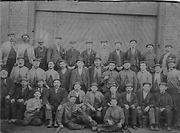 Donated by Mr. David Payne
Donated by Mr. David PayneDated 1901
CMEW workers in 1901. Samuel Charles Payne, seated immediately in front of the bowler-hatted Foreman, was an Iron Turner, but sometime before 1911 left to open a General Dealers shop in Corporation Road, (Old) Hartlepool.
More detail » Scragged
Scragged
“Scragged” by Mr. Allan (Jacko) Jackson.
In the late 1950s or early 1960s I remember an Apprentice being “scragged” by two other Apprentices. He was wrapped up in tape up to his neck and then pushed into view on a gangway where he was seen by the Foreman and sent home for three days (with loss of pay), as a punishment. His two assailants went to the Foreman and confessed, getting the lad’s punishment rescinded. The two escaped punishment themselves, and were simply told to “go away”!
More detail » Shell inspection
Shell inspection
 Created by unknown
Donated by Hartlepool Museum Service
Created by unknown
Donated by Hartlepool Museum ServiceInspecting the shells prior to bonding.
More detail » Shell inspection (1)
Shell inspection (1)
 Created by unknown
Donated by Hartlepool Museum Service
Created by unknown
Donated by Hartlepool Museum ServiceInspecting the shells.
More detail » Shell inspection (2)
Shell inspection (2)
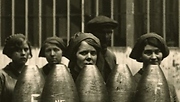 Created by unknown
Donated by Hartlepool Museum Service
Created by unknown
Donated by Hartlepool Museum ServiceInspecting the shells.
More detail » Shell inspection (3)
Shell inspection (3)
 Created by unknown
Donated by Hartlepool Museum Service
Created by unknown
Donated by Hartlepool Museum ServiceInspecting the shells.
More detail » Shell inspection (4)
Shell inspection (4)
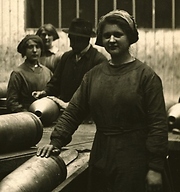 Created by unknown
Donated by Hartlepool Museum Service
Created by unknown
Donated by Hartlepool Museum ServiceInspecting the shells.
More detail » Shell turning
Shell turning
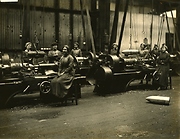 Created by unknown
Donated by Hartlepool Museum Service
Created by unknown
Donated by Hartlepool Museum ServiceFemale lathe operators 'turning' artillery shell cases.
More detail » Shell turning and base ending
Shell turning and base ending
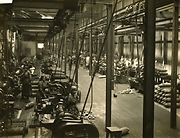 Created by unknown
Donated by Hartlepool Museum Service
Created by unknown
Donated by Hartlepool Museum ServiceThis photo shows the size of the shell factory. The man in the centre of the image is probably a Supervisor or Foreman in charge of the women working at the lathes.
More detail » Shift Number 1 (1)
Shift Number 1 (1)
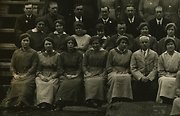 Created by unknown
Donated by Hartlepool Museum Service
Created by unknown
Donated by Hartlepool Museum ServiceNo.1 Shift workers.
More detail » Shift Number 1 (2)
Shift Number 1 (2)
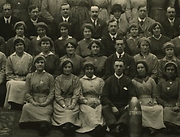 Created by unknown
Donated by Hartlepool Museum Service
Created by unknown
Donated by Hartlepool Museum ServiceNo.1 Shift workers.
More detail » Shift Number 1 (3)
Shift Number 1 (3)
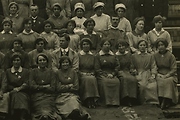 Created by unknown
Donated by Hartlepool Museum Service
Created by unknown
Donated by Hartlepool Museum ServiceNo.1 Shift workers.
More detail » Shift Number 1 (4)
Shift Number 1 (4)
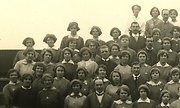 Created by unknown
Donated by Hartlepool Museum Service
Created by unknown
Donated by Hartlepool Museum ServiceNo.1 Shift workers.
More detail » Shift Number 1 (5)
Shift Number 1 (5)
 Created by unknown
Donated by Hartlepool Museum Service
Created by unknown
Donated by Hartlepool Museum ServiceNo.1 Shift workers.
More detail » Shift Number 1 (6)
Shift Number 1 (6)
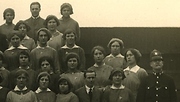 Created by unknown
Donated by Hartlepool Museum Service
Created by unknown
Donated by Hartlepool Museum ServiceNo.1 Shift workers.
More detail » Shift Number 2 (1)
Shift Number 2 (1)
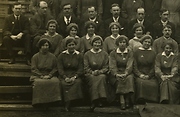 Created by unknown
Donated by Hartlepool Museum Service
Created by unknown
Donated by Hartlepool Museum ServiceNo.2 Shift workers.
More detail » Shift Number 2 (2)
Shift Number 2 (2)
 Created by unknown
Donated by Hartlepool Museum Service
Created by unknown
Donated by Hartlepool Museum ServiceNo.2 Shift workers.
More detail » Shift Number 2 (3)
Shift Number 2 (3)
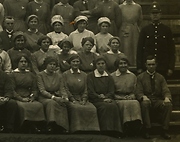 Created by unknown
Donated by Hartlepool Museum Service
Created by unknown
Donated by Hartlepool Museum ServiceNo.2 Shift workers.
More detail » Shift Number 2 (4)
Shift Number 2 (4)
 Created by unknown
Donated by Hartlepool Museum Service
Created by unknown
Donated by Hartlepool Museum ServiceNo.2 Shift workers.
More detail » Shift Number 2 (5)
Shift Number 2 (5)
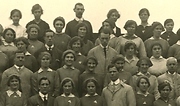 Created by unknown
Donated by Hartlepool Museum Service
Created by unknown
Donated by Hartlepool Museum ServiceNo.2 Shift workers.
More detail » Shift Number 2 (6)
Shift Number 2 (6)
 Created by unknown
Donated by Hartlepool Museum Service
Created by unknown
Donated by Hartlepool Museum ServiceNo.2 Shift workers.
More detail » Ship in North Basin receiving her new boiler
Ship in North Basin receiving her new boiler
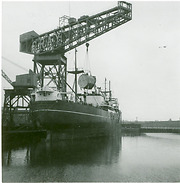 Donated by Hartlepool Museum Service
Donated by Hartlepool Museum ServiceShip in North Basin receiving her new boiler. It is being deliverd by the CMEW Crane.
More detail » Thread milling (1)
Thread milling (1)
 Created by unknown
Donated by Hartlepool Museum Service
Created by unknown
Donated by Hartlepool Museum ServiceThread milling.
More detail » Thread milling (2)
Thread milling (2)
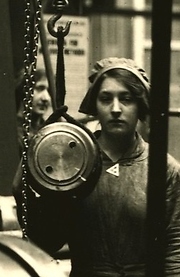 Created by unknown
Donated by Hartlepool Museum Service
Created by unknown
Donated by Hartlepool Museum ServiceThread milling.
More detail » Thread milling (3)
Thread milling (3)
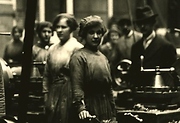 Created by unknown
Donated by Hartlepool Museum Service
Created by unknown
Donated by Hartlepool Museum ServiceThread milling.
More detail » Tool Tally disc from Central Marine Engine Works
Tool Tally disc from Central Marine Engine Works
 Donated by Peter Howard
Donated by Peter HowardTool Tally disc from Central Marine Engine Works. Issued to Peter Howard when he joined the works as an apprentice and had to be produced at the stores every time he wanted to get something from them.
More detail » Town Wall and Fish Sands
Town Wall and Fish Sands
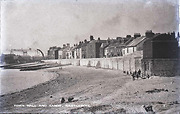 Donated by Hartlepool Library Service
Donated by Hartlepool Library ServiceA view of the Town Wall and Fish Sands. with the swan neck crane and the CMEW Crane in the background.
More detail » Unloading with the Magnet Crane
Unloading with the Magnet Crane
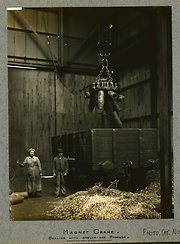 Part of the Hartlepool Museum Service collection
Part of the Hartlepool Museum Service collectionThe magnet was used to handle the heavy shell casings and the large quantities of waste metal, 'turnings', produced when the shell was 'turned' on a lathe.
More detail » Varnishing shells
Varnishing shells
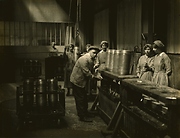 Created by unknown
Donated by Hartlepool Museum Service
Created by unknown
Donated by Hartlepool Museum ServiceVarnishing the shells.
More detail » Varnishing shells (1)
Varnishing shells (1)
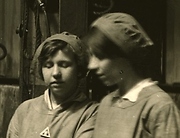 Created by unknown
Donated by Hartlepool Museum Service
Created by unknown
Donated by Hartlepool Museum ServiceWorkers varnishing shells.
More detail » Varnishing shells (2)
Varnishing shells (2)
 Created by unknown
Donated by Hartlepool Museum Service
Created by unknown
Donated by Hartlepool Museum ServiceWorkers varnishing shells.
More detail » Varnishing shells (3)
Varnishing shells (3)
 Created by unknown
Donated by Hartlepool Museum Service
Created by unknown
Donated by Hartlepool Museum ServiceWorkers varnishing shells.
More detail » Wartime New Build (1)
Wartime New Build (1)
 Created by unknown
Donated by Hartlepool Library Service
Created by unknown
Donated by Hartlepool Library ServiceA wartime new build ship alongside the CMEW works. There would appear to have been a mishap with the painting stage, amidships, and a whole tin of white paint has been spilled down the ship's side!
HHT&N 585
More detail » Wartime New Build (2)
Wartime New Build (2)
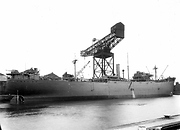 Created by unknown
Donated by Hartlepool Library Service
Created by unknown
Donated by Hartlepool Library ServiceA wartime new build ship alongside the CMEW works. There would appear to have been a mishap with the painting stage, amidships, and a whole tin of white paint has been spilled down the ship's side!
More detail » Women shipbuilders descending the gangway
Women shipbuilders descending the gangway
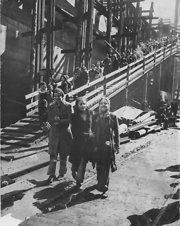 Donated by Hartlepool Museum Service
Donated by Hartlepool Museum ServiceWomen shipbuilders descending the gangway during WW2. It could be lunchtime or the end of their shift.
More detail » Working on a boiler
Working on a boiler
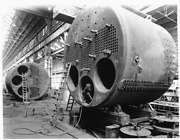 Donated by Douglas Ferriday
Donated by Douglas FerridayPart of the Hartlepool Library Service collection
Man at CMEW working on a boiler.c1962. Wooden ladders and no safety helmet, how times change!
More detail » t.m.v. Lucian on Sea Trials
t.m.v. Lucian on Sea Trials
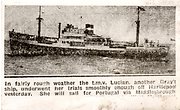 Created by Northern Daily Mail
Donated by Stuart James Wilson
Created by Northern Daily Mail
Donated by Stuart James WilsonDated 1948
Jim Wilson experienced his first sea trials as a marine engineering apprentice aboard this ship, on the 19-20th February 1948. Fellow apprentices were Armstrong, Wanless and Kelly.
More detail »




